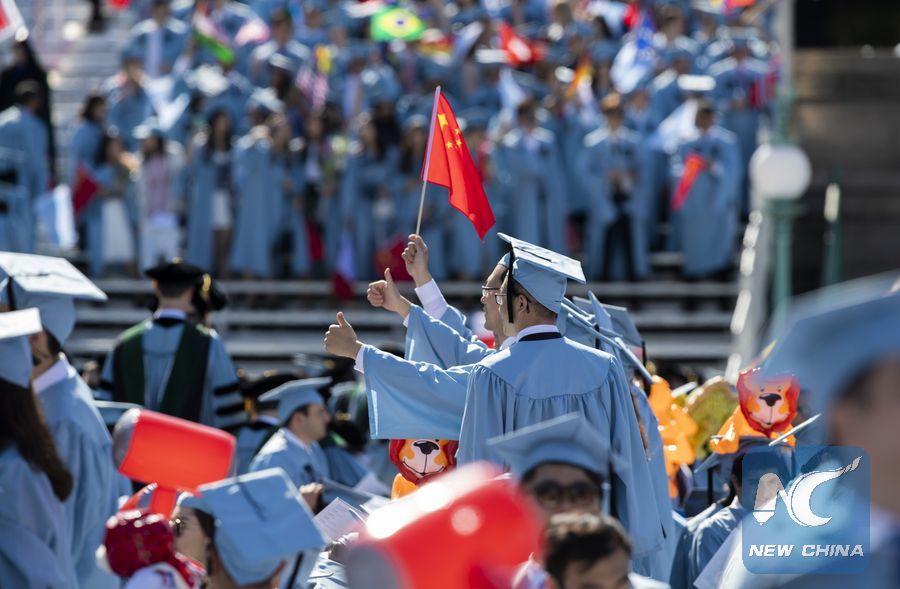
Graduate students from China pose for photos before the Columbia University Commencement ceremony in New York, the United States, May 22, 2019. (Xinhua/Wang Ying)
by Peter Mertz
LARAMIE, the United States, June 12 (Xinhua) -- American educational experts are concerned that declining relations with China will have a negative financial impact on U.S. colleges and universities.
"Declining rapidly," Anthony Ogden, associate vice provost for global engagement at the University of Wyoming, told Xinhua on Tuesday of the overall number of international students coming to the United States to study.
Education is no light-weight in the U.S. import picture. Revenues at degree-granting post-secondary institutions were 649 billion U.S. dollars in 2017, according to the National Center for Education Statistics.
During the past 20 years, from across the globe, each year record numbers of students have come to the United States to attend one of the country's 4,000 highly-regarded colleges or universities.
More significantly, international students typically pay full tuition and boost revenues for schools.
They also spend heavily on buying books, housing and other direct expenses besides tuition. International students -- led by China -- contributed more than 30 billion dollars to the U.S. economy in the 2014-2015 academic year, according to NAFSA: Association of International Educators and the U.S. Commerce Department.
NAFSA, a Washington-based nonprofit group that supports international education, estimates that students from abroad created or sustained more than 455,000 jobs in the United States, almost nine times the number of American coal miners.
The value of education is almost double the revenue from America's top agricultural export in 2017, which is 21.6 billion dollars from soybeans. When other indirect student spending is factored in -- food, cars, clothes -- education's total export value, estimated to double the direct expenses, rivals that of pharmaceuticals and automobiles, which are 51 billion dollars and 53 billion dollars respectively.
"Higher education is one of America's biggest exports," an Institute of International Education (IIE) spokesman said.
HUGE IMPLICATIONS
But this trend may have come to an end, Ogden said, adding that 2018 saw an overall decline in international students attending American schools from 1.12 million to under a million.
In just the past year, the number of international students studying in the United States declined for the first time in decades by 2.7 percent, according to data on student visa holders recently published by U.S. Immigration and Customs Enforcement.
In an exclusive interview with Xinhua, Ogden, a career educator with 30 years of experience in international recruitment and relations at universities such as Michigan State University, said if Chinese enrollment declines as expected, then institutions across the country will soon feel big pain.
"Last year was the first year it's been on the decline," Ogden said. "It has huge implications for schools who turn to international students for revenue," he added.
In the past decade, the number of students from China coming to the United States has quadrupled to almost 400,000.
When Barack Obama was elected U.S. president in 2008, there were 80,127 Chinese students in the United States, according to Statista.
By the time Obama left office in 2016, that number had mushroomed to 350,000 and even nudged further up to 363,341 in 2017, according to data from the Institute of International Education (IIE), a 100-year-old group that monitors international education.
Industry insiders told Xinhua that it appears as if the numbers of students from China are about to plummet, and American educators are wringing their hands wondering how to avert billions of dollars of losses should this happen.
TRADE WAR FALLOUT
"These geopolitical tensions have real implications," said Ogden, who scoffed at political rhetoric that calls Chinese students spies.
The financial downside to fewer Chinese students is staggering.
According to College Board, 2018-2019 tuition fees at American state colleges average 26,290 dollars for out-of-state students or a total contribution of 9.5 billion dollars in tuition expenses per year coming from China.
All that import revenue could vanish overnight, with White House officials consistently threatening additional tariffs and visa restrictions against the world's most populous nation.
Last November, administration officials even discussed the idea of imposing a total ban on Chinese students, according to The Financial Times.
Ogden also noted that with the anti-China rhetoric swirling in the air, Chinese students are being warned of "the risks" of studying in the United States.
China's Ministry of Education early this month warned Chinese students and scholars of the risks of going to study in the United States, citing U.S. visa restrictions, urging them to step up risk assessment and prepare accordingly.
"I can't imagine why anyone from most countries in the world would want to come study here now," said Dr. Betsy Smith, a retired professor of English as a second language at Cape Cod Community College in Massachusetts.
"If you want an education in English, there are other English-speaking countries where the educational system is as good and the atmosphere is more welcoming," she blogged on the Higher Education website last month.

